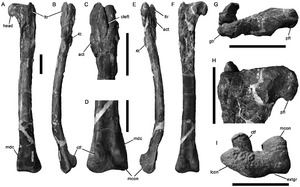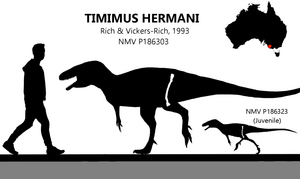Timimus facts for kids
Quick facts for kids Timimus |
|
|---|---|
 |
|
| Holotypic left femur of T. hermani, NMV P186303 | |
| Scientific classification | |
| Genus: |
Timimus
|
| Species: |
hermani
|
Timimus is a small dinosaur that lived in Australia a long, long time ago, during the Early Cretaceous period. It was a type of theropod, which means it walked on two legs and was a meat-eater. Scientists first thought it was related to ornithomimosaurs, which look a bit like ostriches. But now, they think it might be a different kind of theropod, possibly even an early relative of the mighty tyrannosauroids!
Contents
Discovering Timimus
In 1991, two thighbones were found in a place called Dinosaur Cove in southern Australia. One bone belonged to an adult Timimus, and the other to a younger one. They were found very close to each other.
The official name, Timimus hermani, was given by Dr. Thomas Rich and his wife Patricia Vickers-Rich in 1993. The name "Timimus" means "Tim's Mimic." It honors their son, Timothy Rich, and a scientist named Tim Flannery. The "mimic" part was because they first thought it looked like an ornithomimosaur. The second part of the name, hermani, honors John Herman, a volunteer who helped a lot with the dinosaur digs.
The main bone used to describe the species, called the holotype, is named NMV P186303. It was found in a rock layer called the Eumeralla Formation. This layer is about 106 million years old, from the Albian stage of the early Cretaceous period. This bone is the left thighbone of an adult dinosaur.
The second thighbone, from a young Timimus, is called the paratype. Its number is NMV P186323. Scientists have also found other bones, like some vertebrae (backbones), that might belong to Timimus.
What Timimus Looked Like
The adult thighbone is about 44 centimeters (17 inches) long. From this, scientists guess that the whole Timimus was about 2.5 meters (8 feet) long. The bone is quite thin, which suggests Timimus was a light and quick animal. The younger dinosaur's thighbone was 19.5 centimeters (7.7 inches) long.
In 2016, scientists updated their estimates. They now think the Timimus that owned the main thighbone (NMV P186303) might have been around 4.3 meters (14 feet) long and weighed about 200 kilograms (441 pounds).
Scientists look at special features on the bones to identify dinosaurs. For Timimus, they noticed there was no groove between the lower parts of the thighbone. This was an important clue. Also, the top part of the thighbone was flatter from front to back.
Dinosaur Family Tree
When Timimus was first found, scientists thought it belonged to the "Ornithomimosauridae" family. Finding an ornithomimosaur in Gondwana (the ancient supercontinent that included Australia) was rare. This discovery made scientists think that this group of dinosaurs might have started in the Southern Hemisphere.
However, other scientists soon wondered if Timimus really belonged to that group. Today, most experts agree that Timimus does not have the special features that would prove it's an ornithomimosaur. It's still considered a type of coelurosaur (a group of theropods), but its exact place in the dinosaur family tree is still debated. Some even call it a nomen dubium, which means "doubtful name," because there isn't enough clear evidence from the bones to be sure.
But in 2012, a study suggested that Timimus might actually be a valid tyrannosauroid. This idea was also supported by other research in 2018. This means it could be an early relative of famous dinosaurs like Tyrannosaurus rex!
Life in Ancient Australia
The place where Timimus lived was very different from Australia today. During the Early Cretaceous, this area was much closer to the South Pole. This meant it had polar forests with mild summers, but cold and dark winters.
In 1996, a scientist named Anusuya Chinsamy-Turan studied the bones of Timimus and another dinosaur called Leaellynasaura. She found that their bones grew differently. The Leaellynasaura bones showed steady growth, but the Timimus bones showed a pattern of growth that stopped and started. This suggests that Timimus might have hibernated during the colder, darker winter months, just like some animals do today!
Scientists also found a fossil of a toe bone, possibly from Timimus, near Inverloch, Victoria. This bone had a break on the bottom surface, which shows that even dinosaurs could get injuries!
See also
 In Spanish: Timimus hermani para niños
In Spanish: Timimus hermani para niños


